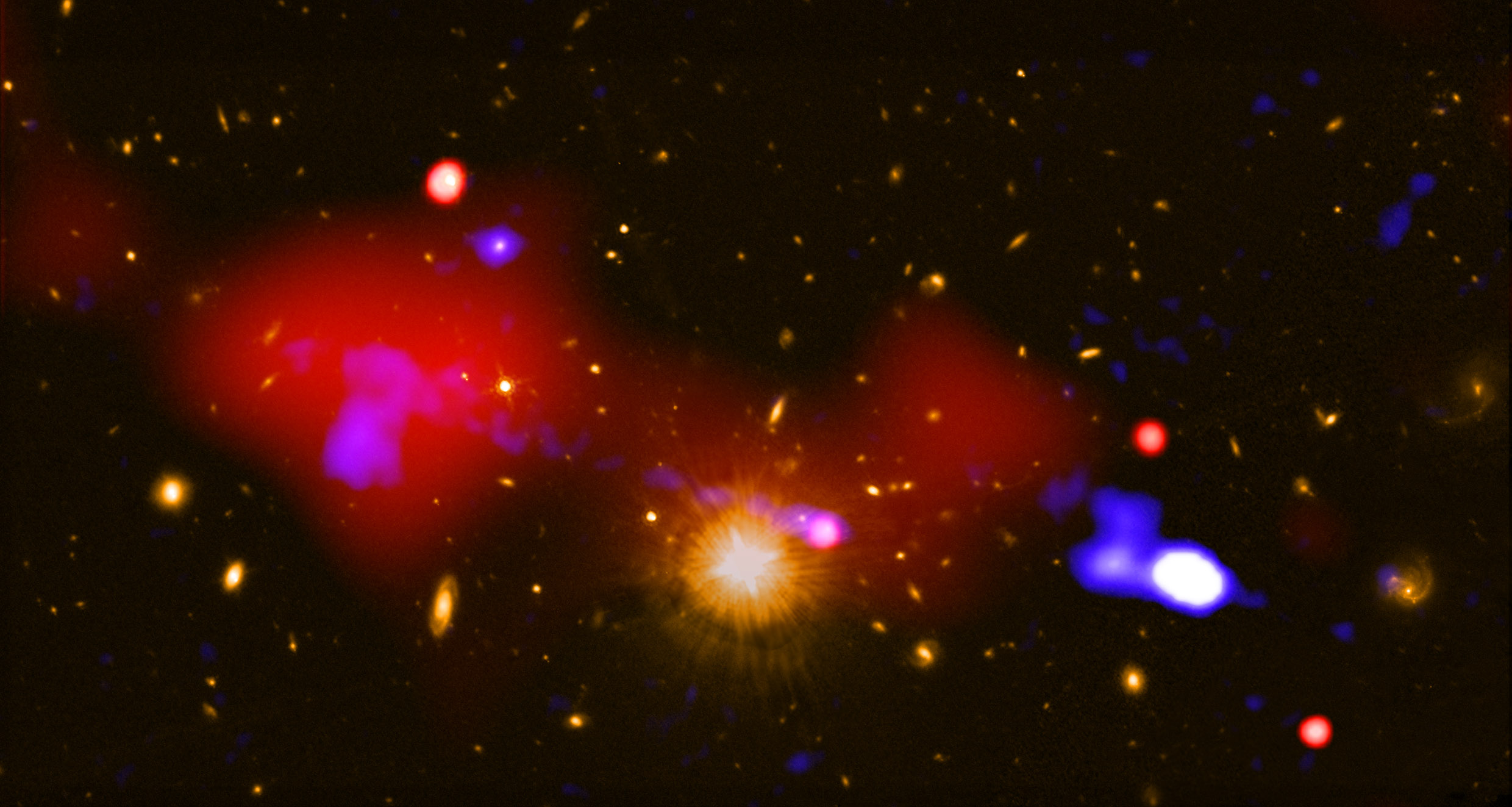
Dark companions, dark matter, dark energy: astronomy finds the invisible more interesting than that which glows.
Some statements sound trite, but they are worth uttering anyway; and once we do utter them, they turn out not to be so trite after all. Take the (quite obvious) idea that, throughout the bulk of its history, astronomy’s only research material has been electromagnetic radiation reaching the Earth from space. The last several decades of new technology and space flights are but a tiny fraction of history. Most of the time, what the human study of space amounted to was this: we watched the visible spectrum as it arrived from the sky (in the 20th century, we also had radio waves and other electromagnetic spectra to contemplate), trying to analyse and make sense of our observations.
Once we have reached that conclusion, we are only a step away from another semi-trite remark: it’s the glowing stuff that astronomers like the most; whether it’s an astral body’s own light (that of stars, galaxies or, to name a less obvious example, meteors) or reflected light (planets, comets or moons). There needs to be some sort of light if we are to observe the object directly. That which is dark (and thereby doesn’t radiate and is not within an electromagnetic spectrum we can grasp) can only be detected indirectly – and that obviously makes the whole process a lot more difficult. It has always been this way and still is. Even though we live in the first half of the 21st century, technology is developing by leaps and bounds; we have left Galileo with his telescope (not to mention the druids of Stonehenge) far behind.
I remember the mirth the title of my MA thesis in physics elicited in my friends who were studying for non-scientific degrees: ‘Search for Algol Variables and Dark Companions in the OGLE Observational Data’. The phrase ‘dark companions’ seemed to be everyone’s favourite. A star’s dark companion does not glow on its own, or glows so weakly that its light vanishes in the glow of the main star.
A dark companion may be a planet or a small star (for instance, a brown dwarf) whose light is weaker by orders of magnitude than that of the main ingredient. We need not search for examples in faraway orbits: for an observer on Sirius or Altair, the Earth or Jove are the sun’s dark companions – or whatever the sun is called in Sirian-Altairian.
We know what it is not
Are dark companions synonymous with the famed dark matter? Not at all. Dark matter is matter whose existence we can only infer indirectly, based on gravitational reactions. What does that actually mean? I am keen to avoid equations, so I will put it this way: if I’m observing an object (a star, planet, anything) and see that another object is revolving around it (a moon, another planet, a smaller star, etc.), then, knowing the size of the orbit, the orbital period and gravitational constant, I’m able to calculate the mass of the inside object. In mathematical terms, this is very simple: secondary-school maths is enough to complete the rudimentary version of this calculation. We can simply calculate the central mass needed to keep the satellite in a given orbit. This is why astronomers are so keen on one object revolving around another. If what I saw was a bare star in an empty space, it would be much more difficult to calculate its mass and describe it in any sort of detail.
This was school-style reasoning, but the idea behind dark matter is the same. When they see moving astral bodies which interact with one another, astronomers are able to calculate the mass which triggers these interactions (mass is what you need for a gravitational reaction to occur). A similar analysis can be completed for larger and more complex objects, such as galaxies, or indeed the universe as a whole. In other words, the observation of movement in the universe enables us to calculate the mass the universe contains.
There is, however, another way of calculating mass: by aggregating the mass of glowing matter (that which we are able to see). We estimate there are x stars and galaxies in the universe; we know the average mass of one star or galaxy, so we multiply and come up with an estimated total mass of the universe’s glowing matter. This is where we are in for a surprise: the universe contains more gravitationally active matter than it does glowing matter; this difference is known as dark matter.
What is dark matter? It is dark and it is matter: in other words, it by definition exerts a gravitational influence, but it doesn’t glow. That’s not because it happens not to have the right conditions for emitting or reflecting light. This is about something more – a different kind of matter, which does not at all react with electromagnetic radiation. It’s easier to say what dark matter is not than what it is. We mustn’t think of it as a sort of dark gas, diffused in space. Nothing of the sort: such a gas would absorb the radiation flowing through it, and as much would be evident in observations. Nor is matter ‘hidden’ in giant black holes. If such enormous mass were latent in them, we would have noticed that, too – black holes would then behave as light-distorting lenses.
If ‘ordinary’ matter were to be a part of dark matter, it would probably take the form of relatively small, cool objects: old burned-out stars and brown dwarves. The dwarves never emit a bright glow, which makes them difficult to detect (there is a lovely acronym for this: MACHO, or Massive Astrophysical Compact Halo Object). But the majority of dark matter is likely to be non-baryon – in other words, unlike ‘our’ matter, this kind of matter is not composed of protons and neutrons. And so this is not about anti-matter. If anti-matter was present in space in such large quantities, it would come into contact with and annihilate ordinary matter, and that in turn would generate (detectable) gamma radiation. And yet no such radiation is detected. It is therefore likely that dark matter has to do with various kinds of exotic elementary particles, whose existence is a theoretical consideration for physicists. One example of such particles are the WIMPs (Weakly Interacting Massive Particles): gravitation aside, these particles are only subject to weak interaction, not unlike the neutrino. However, what sets them apart from the neutrino is their relatively large mass.
Faster and faster
What, then, is dark energy? It is something else still. We infer its existence from the disparity between gravitational observation and the sum of mass of glowing matter; we postulate the existence of dark energy with a view to explaining the expansion of the universe. Here, we should emphasize the word postulate: to date, dark energy remains a hypothesis, with no conclusive discovery made on that front.
A reminder to those who forgot they had learned about this at school: the universe is expanding. It keeps getting bigger, and galaxies are moving further and further away from each other. But we shouldn’t picture this as insects flying about in a room on a summer day. It’s not that galaxies revolve or move around one another; nor do they escape somewhere. Rather, an ever new ‘somewhere’ keeps emerging. The point is not that galaxies move in space, but… that there is ever more space. This is hard to imagine, given that we are used to calling a metre a metre, and unused to space being dependent on anything. But contemporary physics knows it is not that simple. Space – space in itself, res extensa, as Descartes would have put it – expands and grows from one moment to the next. This is unobservable on the human scale because each metre expands by .007 nanometres – the size of a hydrogen atom – each year. If, however, we take the cosmological scale, we obtain a measurable result: the most distant galaxies move further away at a speed comparable to the speed of light, and scientists have known this since the interwar period.
What has been new in the last quarter of the century, however, is that data demonstrates the universe is expanding at a much quicker pace these days than it used to. This is rather counterintuitive (if, indeed, there is anything intuitive about astrophysics): after all, gravitation ought to slow down the escape of the galaxies. And yet it doesn’t. According to the latest data, it is the pace of expansion that increases. Where can we look for the cause?
In a situation like this, scientists are faced with a number of options. They can come up with amendments to existing theories, with a view to adjusting them to new data (in this case, Einstein’s general relativity theory would be such an adjustment). Alternatively, they can postulate the existence of an as yet unknown phenomenon, which could nonetheless influence the outcomes in an existing model: examples of such postulated phenomena could include a new type of field, unknown in physics – or, indeed, dark energy.
What would dark energy be exactly? It is still just a hypothesis, so, strictly speaking, we don’t know. We do know, however, what requirements it has to meet to interpret the data we have collected. Thinking about dark energy is not unlike thinking about the energy of an empty space. Again, we find this counterintuitive, as we are not used to the idea that metres or kilometres should be vehicles for energy, simply by virtue of them being space. But – advocates of dark energy are likely to respond – while metres and kilometres do have minute quantities of energy in them, kiloparsecs and light years contain a fair bit. Dark energy is incredibly diluted: we would obtain the same density by taking the energy contained in a match head and spreading it across the cubic capacity of Lake Ontario. This is minuscule, but, on the cosmological scale, it does work and makes a fundamental impact on the universe. Dark energy, the energy of bare void, entails negative pressure which only exists in space on account of it being…well, space. It is this pressure that brings about the expansion of the universe, and the sum of dark energy adds up in cosmological scales. There is little of that energy in any given place, but, since it is a property of space itself, it is everywhere – even in the vast, empty spaces between galaxies. For the same reason, the ‘concentration’ of dark energy does not fall as the universe expands: dark energy does not dilute in a similar way as galaxies are ‘diluted’ as they move further and further from one another.
It all sounds enigmatic. Let’s remind ourselves that dark energy is a theoretical proposition whose purpose is to explain the disparities between observations and calculations. This by no means a reason to write dark energy off: the history of physics knows many instances where it took years for the predictions of theoreticians to be corroborated (suffice it to mention no less than 110 years passed from the existence of gravitational waves having been postulated for the first time and these waves having actually been observed; in modern physics, a century is an entire cosmological era). There is, however, one aspect of dark energy of which we can speak with a fair degree of accuracy, and that is how much of it there actually is. Assuming the entire modelling is correct, we commonly accept the following proportions: the ‘ordinary’ matter we know makes up a mere 5% of the universe’s entire energy; for dark matter, it’s 27% and for dark energy, as much as 68%. As is often the case, the hidden controls the course of events to a far greater degree than it would seem at first glance.
I would like to end on a different note. I have a degree in both physics and philosophy. The philosophical aspect matters in this context, in that the philosophy of science finds dark energy (and indeed dark matter) very interesting. We have to bear in mind that dark energy is not just a hypothesis (understood as a phenomenon not yet discoverable in immediate experience). Dark energy is also
a kind of ‘auxiliary postulate’, or even ‘emergency hypothesis’ (and it is sometimes criticized as such). Here’s how it works. We have a certain model of the universe, which we generally find reliable, but new data keep coming in, which don’t seem to fit in that model. We thus have to either revise the theory itself (which is obviously difficult and has far-reaching implications), or propose a new phenomenon (which would explain the data without us getting rid of the earlier theory). In the history of science, there were situations where similar circumstances gave rise to brilliant, almost prophetic concepts which were not confirmed empirically until several decades later. There were also, however, instances of scientists being led astray by their intuition. Only time and new data will tell to which of the two categories dark energy will one day belong.









